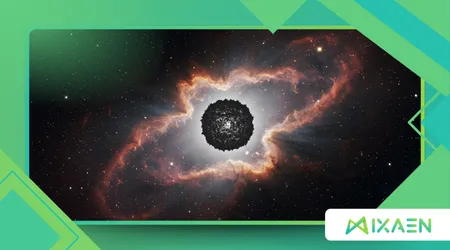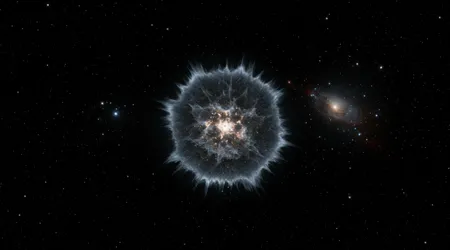Are There Stars Made Entirely of Dark Matter?

Stars made entirely of dark matter captivate the imagination, hinting at cosmic secrets yet to be unveiled.
Anúncios
Could invisible stellar objects, powered not by nuclear fusion but by mysterious dark matter, exist in our universe?
This question, rooted in cutting-edge cosmology, challenges our understanding of stellar formation and the fundamental forces shaping the cosmos.
Recent research, particularly a 2025 study from Durham University, suggests that such exotic entities dubbed “dark dwarfs” might lurk at our galaxy’s heart, glowing faintly not through traditional means but via dark matter interactions.
This article delves into the science, implications, and tantalizing possibilities of these enigmatic objects, exploring whether stars made entirely of dark matter could redefine our cosmic perspective.
With a blend of rigorous analysis and speculative wonder, we’ll unpack the evidence, the theories, and what it all means for humanity’s quest to understand the universe.
Dark matter, an invisible force, shapes galaxies and cosmic structures, yet its nature remains elusive. Unlike ordinary matter, it doesn’t emit or absorb light, making detection tricky.
Scientists infer its presence through gravitational effects, like galaxy rotation curves moving faster than visible matter allows.
Could stars made entirely of dark matter form, defying our stellar models? Let’s explore this cosmic mystery with fresh eyes.
The universe is a vast puzzle, and dark matter is one of its most perplexing pieces. Comprising roughly 26.8% of the universe’s mass-energy, according to the Lambda-CDM model, it binds galaxies together.
Unlike stars fueled by hydrogen fusion, stars made entirely of dark matter would operate on unknown mechanisms, potentially revolutionizing astrophysics. This idea, though speculative, sparks intense debate.
Why does this matter? Understanding dark matter’s role could unlock secrets of cosmic evolution. If stars made entirely of dark matter exist, they might explain anomalies in galactic dynamics.
This article will navigate the science, from theoretical models to observational challenges, offering a clear, engaging path through this cosmic enigma.
The Nature of Dark Matter and Stellar Formation
Dark matter, mysterious and invisible, exerts gravitational pull without interacting with light. Its presence, inferred from galaxy clusters and cosmic microwave background data, shapes the universe’s large-scale structure.
In 2025, the Vera C. Rubin Observatory continues probing dark matter’s distribution, yet its composition remains unknown. Could it form stars made entirely of dark matter?
Ordinary stars ignite through nuclear fusion, fusing hydrogen into helium. Dark matter, lacking electromagnetic interactions, can’t fuse like ordinary matter. However, theoretical models suggest dark matter could clump, forming dense objects.
These hypothetical stars made entirely of dark matter might rely on annihilation processes, where dark matter particles collide, releasing energy.
++ The Great Silence: Why the Universe Isn’t Responding to Us
Consider a brown dwarf, a “failed star” too small for sustained fusion. Recent studies propose brown dwarfs could capture dark matter, heating them internally.
This process, outlined in a 2025 Journal of Cosmology and Astroparticle Physics paper, suggests stars made entirely of dark matter could glow faintly, mimicking stellar behavior without traditional fuel.
The challenge lies in density. Dark matter’s diffuse nature makes compact structures unlikely. Yet, at galactic centers, where dark matter concentrates, conditions might allow such formations.
These “dark dwarfs” could persist longer than typical stars, offering clues to dark matter’s identity.
Imagine a sponge soaking up water this is our analogy for brown dwarfs capturing dark matter.
Just as water changes the sponge’s weight, dark matter could alter a star’s evolution, potentially creating stars made entirely of dark matter that defy conventional stellar lifecycles.

Observational Challenges and Detection Methods
Detecting stars made entirely of dark matter is like chasing shadows in a storm. Since dark matter doesn’t emit light, traditional telescopes struggle.
Scientists rely on indirect signals, like gravitational lensing, where light bends around massive objects. The James Webb Space Telescope, in 2025, scans galactic centers for such clues.
Also read: Why the Cosmic Microwave Background Still Confuses Physicists
A key marker is Lithium-7, which burns quickly in normal stars. Dark dwarfs, powered by dark matter, might retain Lithium-7, offering a unique signature.
The 2025 Durham study suggests statistical analysis of stellar populations could reveal these objects, hidden among ordinary stars.
| Detection Method | Description | Challenges |
|---|---|---|
| Gravitational Lensing | Measures light distortion by dark matter’s gravity | Requires precise alignment, faint signals |
| Lithium-7 Spectroscopy | Detects Lithium-7 in potential dark dwarfs | Limited to specific stellar types |
| Statistical Analysis | Analyzes stellar populations for dark dwarf signatures | Needs large datasets, complex modeling |
Instruments like the Extremely Large Telescope, operational in 2025, enhance our ability to spot faint objects.
Yet, distinguishing dark dwarfs from other low-mass stars remains daunting. Their faint glow demands cutting-edge technology and patience.
Read more: Could the Speed of Light Be Slowing Down Over Time?
Picture a detective sifting through a crowded scene for a single clue. Similarly, astronomers hunt for stars made entirely of dark matter, piecing together subtle hints from a noisy cosmic background, hoping for a breakthrough.
Implications for Cosmology and Astrophysics
If stars made entirely of dark matter exist, they could reshape cosmology. Dark matter’s role as gravitational scaffolding is well-established, but its potential to form stellar-like objects suggests new physics.
Could these stars explain missing mass in galactic centers? The question lingers, sparking debate.
The Durham study estimates 10% of galactic center objects could be dark dwarfs.
This statistic, though preliminary, hints at a hidden population influencing galactic dynamics. Such stars might stabilize galaxies, offering new models for cosmic evolution.
Beyond mechanics, dark dwarfs could reveal dark matter’s particle nature. If they emit energy via annihilation, detecting gamma rays could pinpoint dark matter’s properties, bridging particle physics and astrophysics in 2025’s research landscape.
The discovery would challenge stellar evolution theories. Normal stars die in predictable cycles, but dark dwarfs might endure indefinitely, powered by dark matter’s inexhaustible supply. This longevity could redefine our cosmic timeline.
Think of a lighthouse powered by an unknown fuel, shining endlessly. Similarly, stars made entirely of dark matter could illuminate the universe’s darkest corners, guiding scientists toward profound discoveries.
Philosophical and Cultural Impacts
What does it mean for humanity if stars made entirely of dark matter exist? Beyond science, their discovery would stir philosophical questions about our place in the cosmos.
Are we merely observers of an invisible universe? This idea captivates and humbles.
Culturally, dark stars inspire awe, much like myths of ancient gods. Science fiction, from Star Trek to modern novels, often explores unseen cosmic forces.
Dark dwarfs could fuel new narratives, blending science and storytelling in 2025’s media landscape.
Public interest in astronomy is soaring, with 83% of Americans expressing curiosity about space, per a 2025 Pew Research poll. Discovering dark stars could boost engagement, driving funding for observatories like the Vera C. Rubin.
Religiously, some might see dark stars as divine mysteries, while others view them as natural wonders. This duality enriches discussions, connecting science with human experience in profound ways.
Imagine a child gazing at the night sky, unaware that invisible stars shine above. This poetic image underscores the wonder of stars made entirely of dark matter, inviting us to dream bigger.
The Future of Dark Matter Research

The hunt for stars made entirely of dark matter is just beginning. In 2025, missions like the Vera C. Rubin Observatory aim to map dark matter’s distribution with unprecedented precision. These efforts could confirm or refute dark dwarf theories.
Particle accelerators, like CERN’s Large Hadron Collider, seek dark matter particles. If detected, these particles could clarify whether dark matter can form stellar structures, advancing our understanding by 2026.
Collaborations between observatories and theoretical physicists are vital. By combining data from gravitational lensing and spectroscopy, scientists can narrow the search for dark dwarfs, potentially revolutionizing cosmology.
Public involvement, through citizen science projects, could accelerate discoveries. Platforms like Zooniverse let amateurs analyze telescope data, democratizing the search for stars made entirely of dark matter in 2025.
The journey is akin to exploring an uncharted ocean. Each observation, each theory, brings us closer to understanding whether stars made entirely of dark matter illuminate the cosmic deep.
Conclusion: A Cosmic Frontier Awaits
The possibility of stars made entirely of dark matter ignites curiosity and challenges our cosmic understanding.
These elusive objects, potentially glowing at our galaxy’s core, could unlock dark matter’s secrets, reshape stellar theories, and inspire humanity.
The 2025 Durham study offers a tantalizing glimpse, but the journey is far from over. With observatories like the Vera C. Rubin and telescopes like the James Webb pushing boundaries, we stand on the brink of discovery.
Will stars made entirely of dark matter redefine the cosmos? Only time, and relentless exploration, will tell.
This mystery invites us to look up, question, and dream. As we peer into the universe’s depths, we’re reminded that the unknown is not a barrier but a beckoning frontier.
Let’s embrace the challenge, for the stars visible or not hold answers that could transform our place in the cosmos.
Frequently Asked Questions
What are stars made entirely of dark matter?
They’re hypothetical objects, like dark dwarfs, powered by dark matter annihilation, not nuclear fusion, potentially glowing faintly at galactic centers.
How can we detect these stars?
Through gravitational lensing, Lithium-7 spectroscopy, or statistical analysis of stellar populations, using advanced telescopes like the James Webb.
Why is Lithium-7 important?
It’s a marker for dark dwarfs, as it persists in them but burns quickly in normal stars, per 2025 research.
Could dark stars impact everyday life?
Indirectly, by advancing technology and inspiring cultural narratives, though their primary impact is scientific, deepening our cosmic understanding.
What’s the next step in this research?
Observatories like Vera C. Rubin will map dark matter, while particle accelerators seek its particles, refining theories by 2026.
